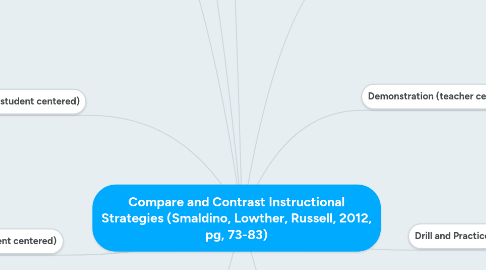
1. Discussion (student centered)
1.1. Advantages
1.1.1. Interesting
1.1.2. Challenging
1.1.3. Inclusive
1.1.4. Opportunity
1.2. Limitations
1.2.1. Potential for limited participation
1.2.2. Sometimes unchallenging
1.2.3. Difficulty level
1.2.4. Age appropriateness
2. Cooperative Learning (student centered)
2.1. Advantages
2.1.1. Learning benefits
2.1.2. Formal or informal
2.1.3. Learning opportunity
2.1.4. Content areas
2.2. Limitations
2.2.1. Size limitation
2.2.2. Potential overuse
2.2.3. Group member limitation
3. Games (student centered)
3.1. Advantages
3.1.1. Engaging
3.1.2. Match to outcomes
3.1.3. Variety of settings
3.1.4. Gain attention
3.2. Limitations
3.2.1. Competition concerns
3.2.2. Levels of difficulty
3.2.3. Expense
3.2.4. Misdirection of intention
4. Simulations (student centered)
4.1. Advantages
4.1.1. Safety
4.1.2. Recreate history
4.1.3. Hands-on
4.1.4. Variety of ability levels
4.2. Limitations
4.2.1. Questionable representation
4.2.2. Complexity
4.2.3. Time factor
5. Discovery (student centered)
5.1. Advantages
5.1.1. Engaging
5.1.2. Repeated steps
5.1.3. Student control of learning
5.2. Limitations
5.2.1. Time factor
5.2.2. Preparation is critical
5.2.3. Misunderstanding
6. Problem-Based Learning (student centered)
6.1. Advantages
6.1.1. Engaging
6.1.2. Context for learning
6.1.3. Levels of complexity
6.2. Limitations
6.2.1. Difficult to create
6.2.2. Age appropriateness
6.2.3. Time-consuming
7. Presentation (teacher centered)
7.1. Advantages
7.1.1. Present once
7.1.2. Note-taking strategies
7.1.3. Information sources
7.1.4. Student presentations
7.2. Limitations
7.2.1. Difficult for some students
7.2.2. Potentially boring
7.2.3. Note-taking difficulty
7.2.4. Age appropriateness
8. Demonstration (teacher centered)
8.1. Advantages
8.1.1. Seeing before doing
8.1.2. Task guidance
8.1.3. Economy of supplies
8.1.4. Safety
8.2. Limitations
8.2.1. Not hands-on
8.2.2. Limited view
8.2.3. Non-flexible pacing
9. Drill and Practice (teacher centered)
9.1. Advantages
9.1.1. Corrective feedback
9.1.2. Information chunking
9.1.3. Built-in practice
9.2. Limitations
9.2.1. Repetitive
9.2.2. Potentially boring
9.2.3. Nonadaptive
10. Tutorial (teacher centered)
10.1. Advantages
10.1.1. Independent work
10.1.2. Self-paced
10.1.3. Individualization
10.2. Limitations
10.2.1. Potentially boring
10.2.2. Possibly frustrating
10.2.3. Potential lack of guidance
